Polish elastic band – universal knitting pattern, Suitable for creating sweaters, hats or children's clothes, allowing you to create beautiful, voluminous, comfortable to wear models.
Performed in several variations, with knitting needles according to patterns, with the obligatory alternation of loops, folding into a vertical pattern, it requires attention and can be easily mastered by novice craftsmen.
What is the pattern?
Polish elastic knitting (the knitting pattern diagram is given below in the article) involves creating a product through a repeating rapport, constantly shifting slightly from row to row, which involves alternating front and back loops.
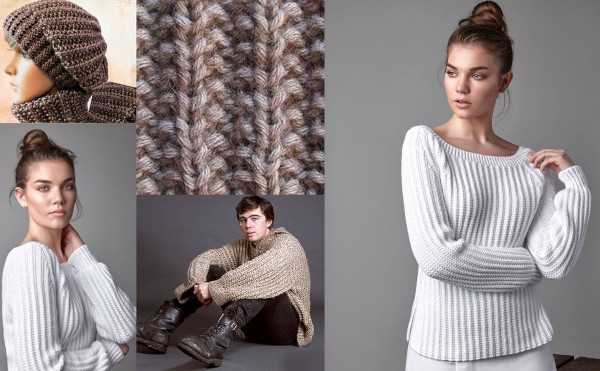
The finished product acquires a distinct structure (the front loops create convex lines, and the back loops create depressions), and due to the convergence of straight vertical lines, volume and good stretching of the fabric are ensured. There are several ways to create a Polish elastic band:
Classic version
The first classic version involves knitting a pattern on 2 knitting needles with constant alternation of rows, while the first will contain 2 purl and 2 front loops, and in the second, the rapport will always begin with a purl and end with a front loop.
Pattern diagram:
| 1st row | 2 front + 2 back loops. |
| 2nd row | 1 purl + 2 knit + 2 purl + 1 knit stitch. |
| 3rd and all subsequent odd rows | Knit exactly like the first row. |
| 4th and even rows | Must repeat the rapport of the 2nd circle. |

- │ — designation of facial loops;
- — — purl stitches.
The specified rapport is repeated throughout the entire row when knitting, and it always begins and ends with an edge loop.
Leningrad rubber band
The knitting pattern for Polish elastic, also known as “Leningrad elastic”, involves creating a pattern on 2 knitting needles with a mandatory set of loops in a multiple of 4 + 2 edge loops.
Rapport scheme:
| 1st row | 1 purl + 3 front loops (in this case, the 1st and 3rd loops should be knitted behind the front wall, and the back loop should be knitted behind the back wall) |
| 2nd row | 1 knit + 1 purl + 2 knit stitches |
| 3rd and all subsequent odd rows | Knit exactly like the first row |
| 4th and even rows | Performed in a 2nd circle rapport |
When knitting, the rapport is repeated throughout the entire row, with each row beginning and ending with edge loops - one at the beginning and one at the end.
In a circle
Polish elastic knitting (the knitting pattern in a circle is slightly different from the classic version of the pattern), when knitting in a circle requires the use of knitting needles of a smaller size than recommended by the manufacturer for this yarn, which will allow you to get a beautiful voluminous pattern.
Rapport scheme:
| 1st row | 1 purl + 3 knit stitches |
| 2nd row | 2 purl + 1 knit + 3 purl + 1 knit + 1 purl loops |
| 3rd row and all odd rows | Performed according to the pattern of the first row |
| 4th circle and all even | Knitted according to the rapport of the 2nd round |
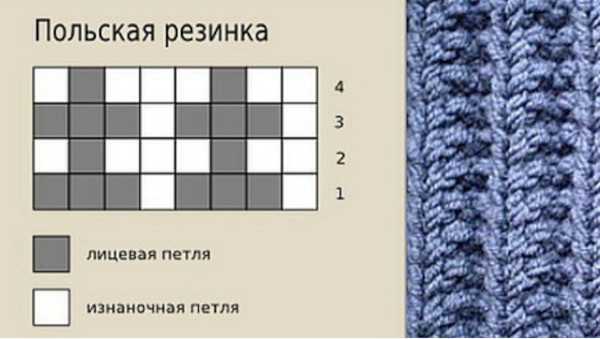
The rapport is repeated throughout the row, with each circle beginning and ending with an edge loop. When knitting in the round, you should also remember that the front loops should be knitted behind the front wall, and the back loops as if they were wrapped around the working needle.
With the definition of the central loop
The fourth method of knitting with Polish (or faceted) elastic involves determining the central loop in each knitted circle, this requires:
- Cast on a number of stitches that can be easily divided into 4 and add 2 edge stitches to them.
- Knit the 1st and 2nd rows with a regular elastic band, alternating 2 front and 2 back loops.
- When working the 3rd row, use a marker to mark the “center loop” and knit it together with the purl loop on the left. All remaining loops in the row should be purl.
- The next 4th and 5th rows are knitted with front and back loops, and on the 6th row, perform the rapport of the 3rd row.
If the pattern is executed correctly, clear vertical lines – edges – will appear on the canvas.
Necessary materials
Professionals consider thick, woolen yarn made from sheep, merino wool or mohair to be the most suitable for knitting with Polish elastic, but when choosing it, you need to make sure that it is soft and does not have any roughness that could cause discomfort when worn.
A mandatory condition is the addition of 10-15% acrylic or nylon to the wool thread.
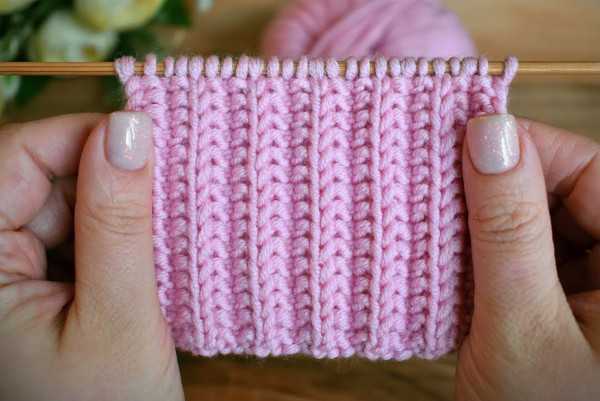
Among the yarns suitable for knitting:
- Pekhorka;
- Lana Gatto;
- Drops Design;
- Wolly Baby.
For creating children's items, it is best to use wool yarn from alpaca or mohair, with the obligatory addition of synthetic fiber, which gives the product softness and also makes it more wear-resistant.
For example:
- Alize;
- Pekhorka children's novelty;
- Merino Extra Fine 100%;
- Drops Baby Merino.
You will also need:
- Knitting needles No. 4 (suitable for thick yarn). Experts advise beginners to take straight or circular knitting needles made of wood or bamboo, if possible avoiding bulkier metal products at first.
- marker;
- thread with a needle;
- scissors.
Product diagrams with description of work
Polish elastic knitting (the knitting pattern assumes a clear repetition of the rapport along the entire row) is carried over to universal, relief patterns that look advantageous on voluminous products, well-stretched, soft and warm scarves, hats, sweaters.
Snood
Knitting a snood with a Polish elastic stitch requires the use of 300-500 g of wool yarn (for example, Alize Lanagold), as well as circular knitting needles No. 4 or 5.
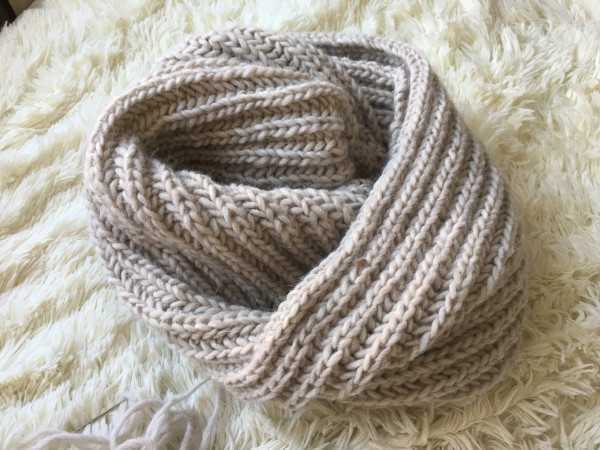
When performing work, you need to:
- Cast on 110 stitches on the knitting needles (their number can vary depending on your own desire, but it should always be divisible by 4 + 2 edge stitches) and join them into a circle.
- Form the first row of the product, for which the edge loops should be transferred to the working knitting needle and start forming the pattern, knitting a rapport of 3 front loops + 1 purl along the entire row. The circle is completed with an edge loop.
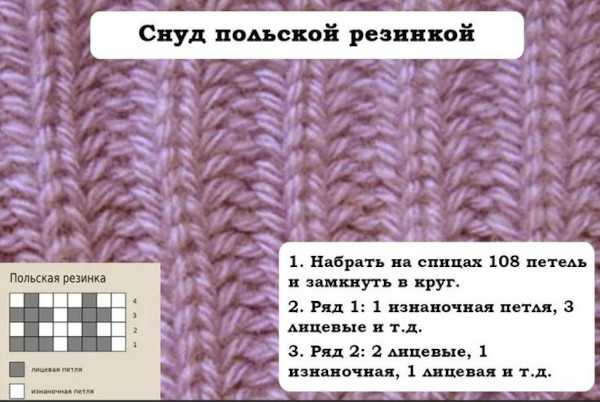
- When forming the second row, remove the edge loop and make a circle with the pattern - 2 front loops + 1 back loop + 1 front loop. The row ends with an edge loop.
- Next, alternating the pattern of the 1st row in the 3rd, 5th, 7th and subsequent odd rows and the rapport of the 2nd circle in the 4th, 6th, 8th and even rows, you need to make a fabric of 50-70 cm. At the same time, its width should be at least 25-35 cm, which will allow you to wrap it around your neck several times.
- Perform simultaneous closing of all loops as soon as the fabric reaches the desired size.
Children's scarf
A children's scarf with a Polish (faceted) elastic is knitted according to a pattern with constant alternation of front and back loops in a row (3 and 1).

To do this you will need:
- 100 g of Pekhorka yarn (with 50% wool and acrylic content);
- straight knitting needles No. 3.
The length of the finished product will be approximately 1 m, with a width of 11 cm, and you will need:
- Cast on 30 (28 working + 2 edge) stitches and knit:
- 1st row – remove the edge loop + repeating rapport of 3 front and 1 back loop. It ends with a back loop and an edge loop, knitted as a back loop.
- 2nd row – remove the edge stitch and make a repeating pattern of 2 front and one back stitch. The last stitch in the row will also be a back stitch + a back stitch edge stitch.
- Proceeding in a similar manner, you need to complete 60 cm of fabric, while the pattern of the 3rd and all odd rows should match the first, and the 4th and all even rows - with the second.
- After the product reaches the desired length, you can start closing the loops, for which in 3 rows you will first need to knit 2 loops together 3 times, and then close 3 loops at once.
- Pull the remaining loops together, secure them and hide the tip on the inside of the model.
Hat with a turn-up
Polish elastic knitting (the knitting pattern may differ depending on the chosen pattern) looks good in adult and children's hats with a lapel and a pompom.
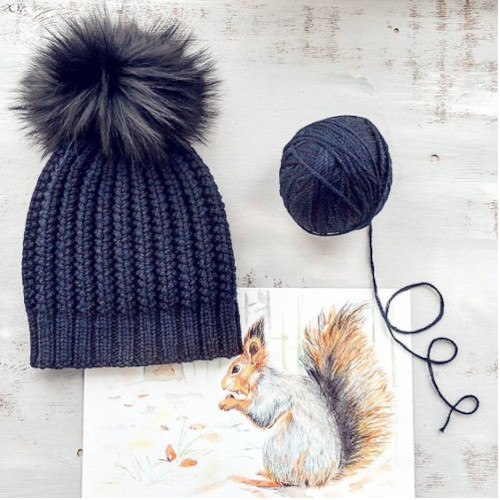
For knitting you will need:
- 100 g of yarn (for example, Alize Superwash, with 70% merino wool and 25% polyamide);
- circular knitting needles No. 3.5;
- threads with a needle.
- scissors.
The length of the hat is approximately 34 cm, while the knitting density will be 2 loops. The rapports "Polish elastic" will be used in the work - 4 loops, 2 rows.
Knitting pattern with turning rows:
| 1st row | 2 knits + 1 purl + 1 knit stitch |
| 2nd row | 3 knits + 1 purl |
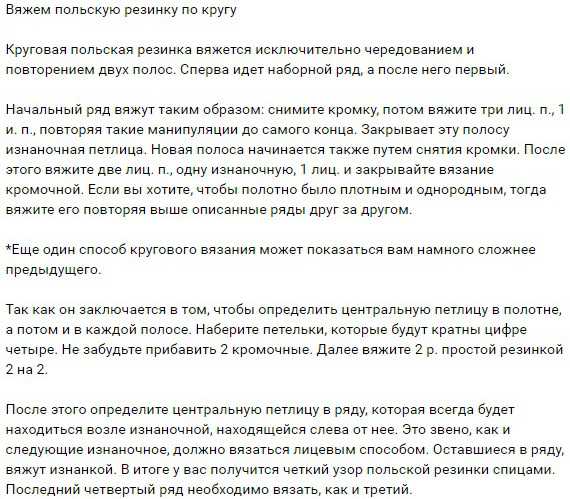
Knitting pattern in a circle:
| 1st row | 3 knit stitches + 1 purl stitch |
| 2nd row | 1 purl + 1 knit + 2 purl stitches |
When knitting the product you will need:
- Cast on 90 stitches, join them into a ring and knit first using the Polish elastic pattern in “turning rows” for 5 cm of fabric to form the lapels.
- Continue knitting in a circle pattern until the hat reaches a length of 15-20 cm (excluding the lapel).
- Proceed to close the crown, for which:
- 1st row: perform the following pattern: 1 front + 3 back loops together;
- 2nd row knit with the pattern – 1 front + 1 back loop;
- 3rd row – knit together 2 front loops through the front walls (1st – purl, 2nd – front);
- 4th row – gather the remaining loops with a needle and tighten into a circle. The remaining thread should be pulled to the wrong side of the model.
The finished hat should be tried on and, if desired, decorated with a fur or thread pompom by sewing it to the crown.

In the latter case, you need to:
- Place the round neck of a glass or jar on a sheet of cardboard and trace around it with a pencil.
- Cut out 2 circles, place a coin in their center, make an additional small circle and cut it out.
- Place the resulting blanks on top of each other and separate a small section of cardboard with scissors, and then, without separating them, wrap the template in a circle with woolen thread (the more there is, the more voluminous the pompom will be).
- Pass the yarn along the fold line between the cardboard blanks, thread a piece of thread between them and knit a pompom.
- Remove the template, trim the pompom with scissors and sew it to the top of the hat.
In a similar way, you can knit a hat with a pompom for a child. In this case, the number of loops on the needles will need to be reduced depending on the size of the child's head.
Beret
Polish (faceted) elastic knitted with knitting needles is often used in the manufacture of fashionable women's berets. This model is considered universal, suitable for almost all women and girls, and the rapport chosen for knitting, according to the scheme, will make it more voluminous and fashionable.
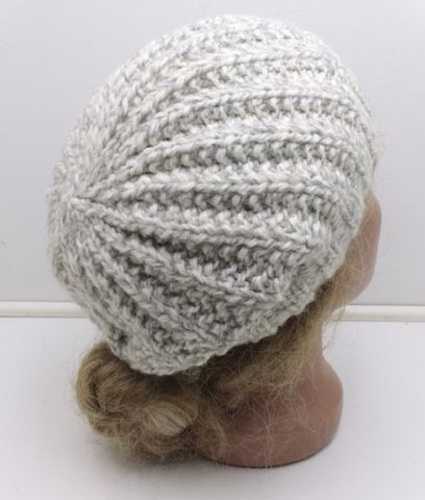
When knitting, it is better to use 100 g of soft melange yarn, as well as knitting needles No. 2.5 and 4.
The beret is knitted using the classic version of Polish elastic, and you need to:
- First, cast on 90 stitches on knitting needles No. 2.5 and knit a 6 cm high fabric with a 2*2 elastic pattern (alternating 2 purl and 2 knit stitches).
- Change to #4 knitting needles and add an extra stitch to the last row to create an odd number of stitches.
- Continue knitting with the Polish rib pattern, for which:
- in the 1st row, perform one edge stitch + a pattern of 2 purl and 2 front stitches.
- In the 2nd row, knit a pattern of 1 purl + 2 knit and 2 purl + 1 knit stitch.
- In a similar manner, alternating the pattern on even and odd rows, complete 10 cm of the product, after which proceed to forming the crown and narrowing the loops. In this case, you need to:
- in the 1st row close every third loop;
- Knit the 2nd row according to the pattern;
- in the 3rd round, close every second loop;
- in the 4th row, keep the pattern;
- Complete the 5th row by knitting 2 front loops together;
- Knit the 6th row with purl stitches, then pull them together and sew, and pull the end of the thread through the closed stitches and hide it on the back side.
If you want to make the hat more voluminous after knitting with a 2*2 elastic, you will need to make an additional increase in every 5th loop in each subsequent row, which will make the crown higher (up to 5-10 cm).
Sweater
The "Polish" rib pattern looks most advantageous in voluminous, men's sweaters of a sporty style. Thanks to the beautiful verticals, it turns out to be quite voluminous, and the product itself will have the most free cut.
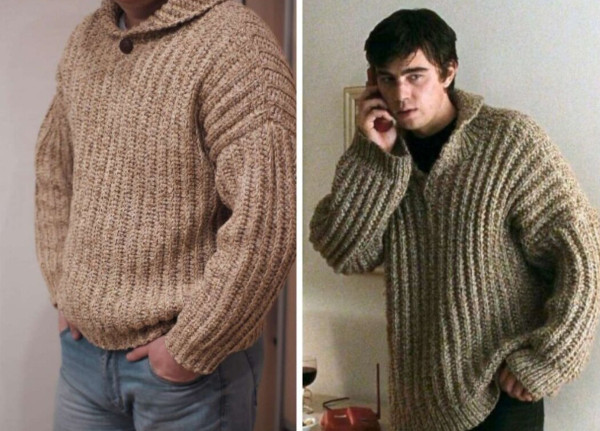
Suitable for knitting:
- 153 m/90 g of wool yarn “Derevenka” (with 100% merino wool content);
- knitting needles No. 3.5 and 4.
To knit a sweater, take 2 patterns:
- simple elastic band 1*1;
- Polish elastic band.
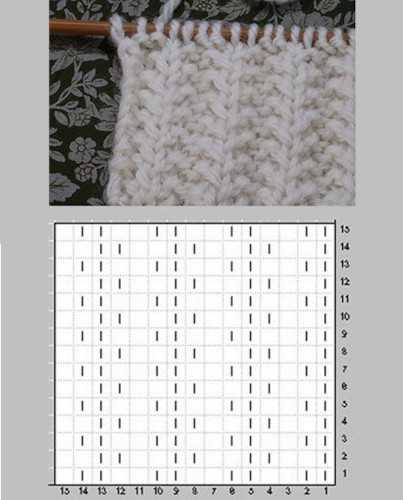
The pattern used is:
| 1st row | 1 edge loop + repeating pattern in a circle of 1 front and 3 back loops. The row ends with a front and edge loop. |
| 2nd round | 1 edge + repeating rapport – 2 purl + 1 knit + 1 purl stitches. The row ends with 1 purl stitch and a purl edge stitch. |
| 3rd row and all odd | Knit in the same way as the 1st round. |
| 4th row and all even | Must copy the rapport of the 2nd circle. |
The product is knitted without armholes, with obligatory bevels on the shoulders and a slight sleeve cap.
To form the front you will need:
- Cast on 110 stitches onto 3.5 knitting needles and knit 18 rows with a 1*1 rib pattern (alternating front and back stitches).
- Switch to 4.5 mm knitting needles and knit 158 rows using the Polish rib pattern according to the diagram.
- Reduce the row by 10 central loops and proceed to work on each half of the product separately, reducing one loop in every 4th row when knitting the pattern.
- Having completed 180 from the cast-on edge, move on to forming the shoulder bevels, for which in every 2nd row you need to knit 2-6 loops.

The back of the product is knitted in the same way as the front part.
For the sleeves you should:
- Cast on 64 stitches with knitting needles No. 3.5 and work 18 rows with 1*1 rib pattern.
- Having added 6 loops to the cast-on row (there should be 70 of them on the knitting needles in total), switch to the “Polish elastic” pattern.
- Adding 1 additional loop in every 6th row, complete 102 rows.
- Start forming the cuff and decreasing by decreasing 3 stitches on each side in every 2nd row (you will need to do this 10 times in total).
- For the collar you need:
- Cast on 110 stitches on knitting needles No. 3.5 and knit with a 1*1 rib pattern 5 cm of fabric.
- Remove 2 loops from both sides, knit them together and make 15 cm of the product.
- To form a sweater, all its parts must be sewn together along the hidden seams from the inside and tried on.
Tips for Beginners
When working on the "Polish elastic" pattern, experienced craftsmen recommend that beginners remember some nuances.

So:
- Despite its versatility, it is not used for knitting sleeves and collars, as it does not stretch well enough and gives additional volume to parts of the finished product.
- When planning to work on a hat, it is best to buy circular knitting needles without a seam, connected by a 40 cm fishing line. Wooden or bamboo products are suitable for beginners, and after purchasing them and before starting to knit, it is recommended to place the fishing line in a vat of hot water for 15 minutes, which will make it softer and facilitate the work process.
- When knitting with a Polish elastic, it is advisable to use thick, high-quality wool yarn. It is also recommended to fold a thinner thread from one skein in half. This can be done using the ends located outside and inside. It is not recommended to use thin synthetic or low-quality yarn for work, since the resulting product may prick, causing discomfort when worn and quickly losing its original appearance.
- It is better to take straight or circular knitting needles for Polish ribbing in several sizes - for the main pattern and 1-2 sizes smaller than the manufacturer recommends for the selected yarn, which will make the finished product more voluminous and airy.
- Be sure to keep a notebook or a workbook in which you will write down all the information about the manufacturer, color and thickness of the yarn, calculations made and the number of loops cast on.
- It is necessary to use a marker when knitting (it is especially necessary when choosing a pattern that requires knitting a central loop). It is necessary to mark the end of the cast-on row with it when forced to stop working.
- Before using, it is recommended to hand wash the finished product in warm, soapy water. You can also add a little fabric softener, then rinse well and squeeze gently. This is done to remove the factory wax from the threads, straighten them and make the product soft.
Polish (Leningrad or faceted) elastic is a universal pattern suitable for knitting various hats, scarves and sweaters.
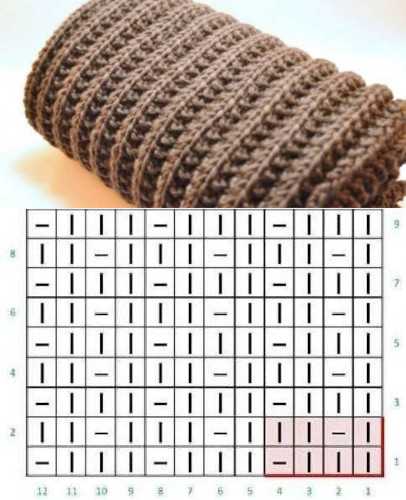
It is quite simple to perform, but requires strict adherence to the selected pattern, it allows you to make the finished product more voluminous and embossed, perfectly fitting into the oversized style, but for this it requires the obligatory choice of only high-quality wool yarn and a smaller size of knitting needles than recommended by the manufacturer.
Video about Polish elastic knitting
Knitting a hat "Pumpkin" with Polish elastic:
